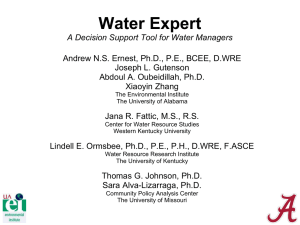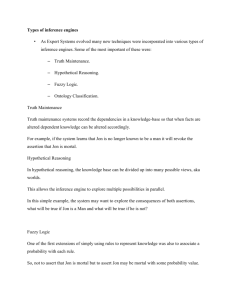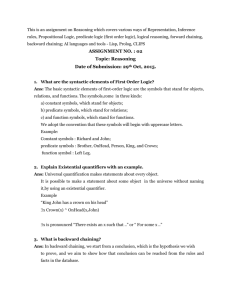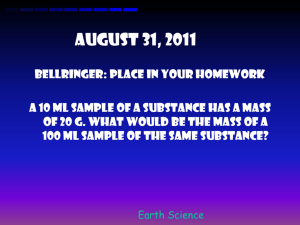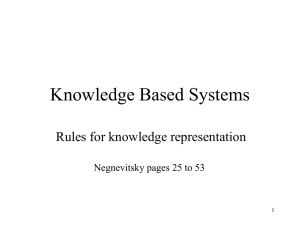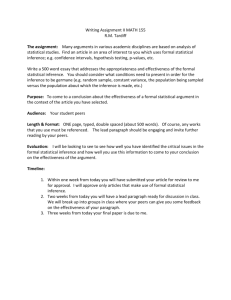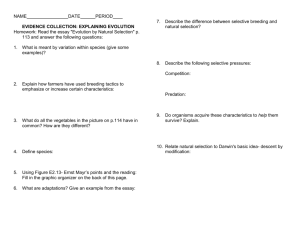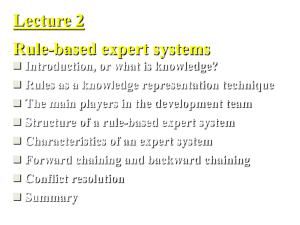Lecture 8: Rule-Based Reasoning
advertisement
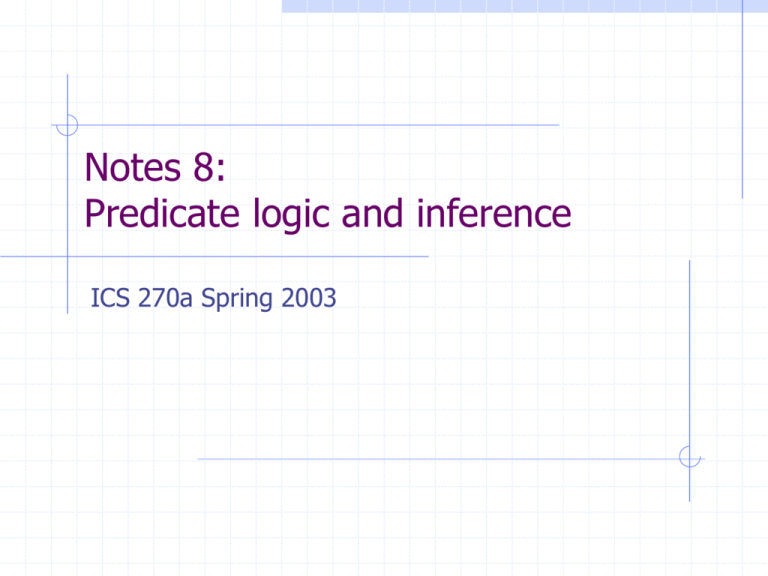
Notes 8:
Predicate logic and inference
ICS 270a Spring 2003
Outline
New ontology
objects,relations,properties,functions.
New Syntax
Constants, predicates,properties,functions
New semantics
meaning of new syntax
Inference rules for Predicate Logic (FOL)
Resolution
Forward-chaining, Backword-chaining
unification
Readings: Nillson’s Chapters 15-16, Russel and Norvig Chapter 8,
chapter 9
Propositional logic is not expressive
Needs to refer to objects in the world,
Needs to express general rules
On(x,y) ~ clear(y)
All man are mortal
Everyone who passed age 21 can drink
One student in this class got perfect score
Etc….
First order logic, also called Predicate calculus allows more
expressiveness
Syntax
Components
Infinite set of object constants, alphanumerc strings
Bb, 12345, Jerusalem, 270a, Irvine
Function constants of all aritys (convention: start with lower case)
motherOf, times, greaterThan, color
Relation constants, Predicates of all aritys (start with capital)
B21, Parent, multistoried, XYZ, prime
Terms
An object constant is a term
A function constant of arity n followed by n terms in parenthesis is
a term (called functional expression)
motherOf(Silvia), Sam, leftlegof(John), add1(5), times(5,plus(3,6))
Wffs sentences
An atomic sentence is formed from a predicate (relation)
symbol followed by a parenthesized list of symbols
Atoms: a relation constant (predicate) followed by n terms in
parenthesis seperated by commas.
GreaterThan(6,3), Q, Q(A,B,C,D), Brother(Richard,John)
Married(FatherOf(Richard),MotherOf(John))
Complex propositional wffs:
,, ,
Use logic connectives:
Brother(Richard,John) /\ Brother(John,Richard)
Older(John,30) V Younger(John,30)
Older(John) --> ~Younger(John,30) V P
Semantics: Worlds
The world consists of objects that has properties.
There are relations and functions between these objects
Objects in the world, individuals: people, houses, numbers,
colors, baseball games, wars, centuries
Clock A, John, 7, the-house in the corner, Tel-Aviv
Functions on individuals:
father-of, best friend, third inning of, one more than
Relations:
brother-of, bigger than, inside, part-of, has color, occurred after
Properties (a relation of arity 1):
red, round, bogus, prime, multistoried, beautiful
Semantics: Interpretation
An interpretation of a wff is an assignment that maps
object constants to objects in the worlds,
n-ary function symbols to n-ary functions in the world,
n-ary relation symbols to n-ary relations in the world
Given an interpretation, an atom has the value “true” in case it
denotes a relation that holds for those individuals denoted in
the terms. Otherwise it has the value “false”
Example: A,B,C,floor,
On, Clear
World:
On(A,B) is false, Clear(B) is true, On(C,F1) is true…
Semantics: Models
An interpretation satisfies a wff (sentence) if the wff has
the value “true” under the interpretation.
An interpretation that satisfies a wff is a model of that
wff
Any wff that has the value “true” under all
interpretations is valid
Any wff that does not have a model is inconsistent or
unsatisfiable
If a wff w has a value true under all the models of a set
of sentences delta then delta logically entails w
Example of models
The formulas:
On(A,F1) Clear(B)
Clear(B) and Clear(C) On(A,F1)
Clear(B) or Clear(A)
Clear(B)
Clear(C)
Possible interpretations which are models:
On = {<B,A>,<A,floor>,<C,Floor>}
Clear = {<C>,<B>}
Quantification
Universal and existential quantifiers allow expressing general
rules with variables
Universal quantification
All cats are mammals
x Cat ( x) Mammal ( x)
It is equivalent to the conjunction of all the sentences obtained by
substitution the name of an object for the variable x.
Syntax: if w is a wff then (forall x) w is a wff.
Cat ( Spot ) Mammal( Spot )
Cat ( Rebbeka) Mammal( Rebbeka)
Cat ( Felix ) Mammal( Felix )
,,,,
Quantification: Existential
Existential quantification : an existentially quantified sentence
is true in case one of the disjunct is true
xSister ( x, spot ) Cat ( x )
Equivalent to disjunction:
Sister(Spo t , Spot) Cat(Spot)
Sister(Reb ecca,Spot) Cat(Rebecca)
Sister(Fel ix,Spot) Cat(Felix)
Sister(Ric hard,Spot) Cat(Richar d)...
We can mix existential and universal quantification.
Useful Equivalences
De Morgan laws
Inference rules:
Universal instantiation: foall x f(x) |-- f(alpha)
Existential generalization: from f(alpha) |-- exist x f(x)
Modeling a domain; Conceptualization
The kinship domain:
object are people
Properties include gender and they are related by relations such as
parenthood, brotherhood,marriage
predicates: Male, Female (unary) Parent,Sibling,Daughter,Son...
Function:Mother Father
Resolution in the predicate calculus
Unification
Algorithm unify
Using unification in predicate calculus resolution
Completeness and soundness
Converting a wff to clause form
The mechanics of resolution
Answer extraction
Inference Rules in FOL
All the inference rules for propositional logic applies and additional
three rules that use substitution; assigning constants to variables
Subst(x/constant)
Subst({x/Sam,y/Pam},Likes(x,y)) = Likes(Sam,Pam)
Universal elimination
From fromall x Likes(x,IceCream) we can substitute {x/Ben} and infer
Likes(Ben,IceCream)
Existential Elimination
For any sentence and for any symbol k that does not appear elsewhere in
the knowledge-base
exists x Kill(x,Victim) we can infer Kill(Murderer,victim)
As long as Murdered soes not appear anywhere
Existential introduction
From Likes(Jerry,IceCream) we can infer exists x Likes(x,IceCream)
Predicate calculus resolution
Suppose the 1 and 2 are two clauses represented as set of
literals. If there is an atom in 1 and a literal ~ in 2 such
as and have a common unifier
Then these two clauses have a resolvent row. It is obtained by
applying the substitution to 1 2 leaving out
complementary literals
Example:
{P( f ( y ), A) Q ( B, C )}, {P( x, A) R( x, C )}
subst
f ( y ) x
Converting to clause form
x, y P( x) P( y ) I ( x,27) I ( y,28) S ( x, y )
P( A), P( B )
I ( A,27) I ( A,28)
I ( B,27)
S ( B, A)
Example: Answer Extraction
Example: Resoluction Refutation
Prove I(A,27)
Rule-Based Systems
Rule-based Knowledge Representation and Inference
combines rules
if DOG(x) then TAIL(X)
with working memory,
DOG(SPOT)
DOG(LUNA)
is not a formal knowledge representation scheme like logic
somewhat like a combination of propositional and FOPL
uses simple methods for inference
often combined with other mechanisms such as inheritance
motivated by practical use rather than theoretical properties
also has some basis in cognitive models
Forward Chaining Procedure
While (rules can still fire or goal is not reached)
for each rule in the rulebase which has not fired
1. try to bind premises by matching to
assertions in WM
2. if all premises in a rule are supported then assert
the conclusion and add to WM
Repeat 1. and 2. for all matching/ instantiation alternatives
end
continue
Example: Zoo Rulebase
Want to identify animals based on their characteristics
could have rules like
if A1 and A2 and A3.....and A27 then animal is a monkey
i.e., one very specific rule per animal
Better to use intermediate concepts
e.g., the intermediate concept of a mammal
if ?x is a mammal and B1...and B3 then ?x is a monkey
Why are intermediate concepts useful?
rules are easier to create
rulebase is easier to maintain
easier to perform inference
however: finding good intermediate concepts is non-trivial!
Where do the rules come from ?
Manual Knowledge Acquisition
interview experts
expert describes the rules
process of translating expert knowledge into a formal
representation is also known as knowledge engineering
this is notoriously difficult
experts are often very poor at explicitly describing what they do
e.g., ask Michael Jordan how he plays basketball or ask Tiger Woods
how he plays golf
Automated Knowledge Acquisition
derive rules automatically from formal specifications
e.g., by automatic analysis of solution manuals
machine learning
Inference Network Representation
has
Wehair
can represent forward chaining with rules as a network:
is a mammal
eats meat
is a carnivore
tawny color
black stripes
has a tail
is a tiger
Inference using Backward Chaining
Establish a hypothesis
e.g., Tony is a tiger
a hypothesis is as assertion whose truth we wish to test
i.e., assert the hypothesis
see if that is consistent with other data
Work backwards, i.e.,
match the hypothesis to the conclusion of the rules
look at the premise conditions of the rule
if these are unknown,
declare these as intermediate hypotheses
backward chain recursively (depth-first manner)
Can use search algorithms to control how backward chaining
proceeds
Inference Network Representation of Backward
Chaining
•
We can represent backward chaining as a network:
has hair
is a mammal
eats meat
forward pointing eyes
has claws
has teeth
tawny color
black stripes
is a carnivore
is a tiger
Backward Chaining Procedure
While (unsupported hypotheses exist or goal is not reached)
for each hypothesis H
for each rule R whose conclusion matches with H
try to support each rule’s premises by
1. matching assertions in WM
2. recursively applying backward chaining
if rule’s premises are supported
conclude that H is true
end
end
continue
Forward Chaining or Backward
Chaining:
which is better?
Which direction is better depends on the circumstances
4 main factors of relevance
the number of possible start states and number of possible goal
states
smaller is better
the branching factor in each direction
smaller is better
what type of explanation the user wants
more natural explanations may be important
the typical action which triggers a rule
i.e., data-driven or hypothesis-driven?
What is a rule-based expert system
(ES)?
ES performs a task in limited domains that require human
expertise
medical diagnosis; fault diagnosis; status monitoring; data
interpretation; mineral exploration; credit checking; tutoring;
computer configuration
ES solves problems by application of domain specific knowledge
rather than weak methods.
Domain knowledge is acquired by interviewing human experts
ES can explain a problem solution in human-understandable
terms
Examples of Expert Systems
1965
1965
1972
1972
1975
1978
1979
1980
1982
1983
1983
1984
1986
1986
1986
1987
1992
1995
1997
DENDRAL
MACSYMA
MYCIN
Prospector
Cadeceus
DIGITALISMIT
PUFF
R1
XCON
KNOBS
ACE
FAITH
ACES
DELTA/CATS
MAX
Stanford
analyze mass spectrometry data
MIT
symbolic mathematics problems
Stanford
diagnosis of blood diseases
SRI
Mineral Exploration
U. of PITT Internal Medicine
digitalis therapy advise
Stanford
obstructive airway diseases
CMU
computer configuration
DEC
computer configuration
MITRE
mission planning
AT&T
diagnosis faults in telephone cables
JPL
spacecraft diagnosis
Aerospace satellite anomaly diagnosis
Cambpell diagnose cooker malfunctions
GE
diagnosis of diesel locomotives
AMEX
credit authorization
NYNEX
telephone network troubleshooting
Caltech
PacBell network management
UCI
planning drug treatment for HIV
Mycin: Diagnosis and treatment of
blood diseases
RULES
PREMISE ($AND (SAME CNTXT GRAM GRAMNEG)
(SAME CNTXT MORH ROD)
(SAME CNTXT AIR AEROBIC))
ACTION: (CONCLUDE CNTXT CLASS ENTEROBACTERIACEAE .8)
If
THEN
the stain of the organism is gramneg, and
the morphology of the organism is rod, and
the aerobicity of the organism is aerobic
there is strongly suggestive evidence (.8) that
the class of organism is enterocabateriaceae
DATA
ORGANISM-1:
GRAM = (GRAMNEG 1.0)
MORP = (ROD .8) (COCCUS .2)
AIR = (AEROBIC .6)(FACUL .4)
The XCON Application
A rule-based expert system
expert in the sense that the rules capture expert design knowledge
addresses a design/configuration problem
Digital Equipment Corporation (or Compaq by now!)
XCON = rule-based expert system for computer configuration
decides how peripherals are configured on new orders
has 10,000 rules
developed in early 1980’s
based on “reactive rule-based systems”
if antecedents then action
forward chaining in style
estimated to have saved DEC several hundred million $’s
Limitations of Rule-Based
Representations
Can be difficult to create
the “knowledge engineering” problem
Can be difficult to maintain
in large rule-bases, adding a rule can cause many unforeseen
interactions and effects => difficult to debug
Many types of knowledge are not easily represented by rules
uncertain knowledge: “if it is cold it will probably rain”
information which changes over time
procedural information (e.g. a sequence of tests to diagnose a
disease)
Summary
Knowledge Representation methods
formal logic
rule-based systems (less formal)
Rule-based representations are composed of
Working memory:
Rules
Inference occurs by
forward or backward chaining
Rule-based expert systems
useful for certain classes of problems which do not have direct
algorithmic solutions
